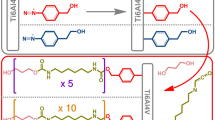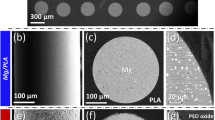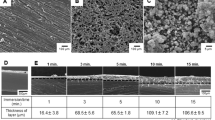Abstract
Periprosthetic osteolysis—bone loss in the vicinity of a prosthesis—is the most serious problem limiting the longevity of artificial joints. It is caused by bone-resorptive responses to wear particles originating from the articulating surface. This study investigated the effects of graft polymerization of our original biocompatible phospholipid polymer 2-methacryloyloxyethyl phosphorylcholine (MPC) onto the polyethylene surface. Mechanical studies using a hip-joint simulator revealed that the MPC grafting markedly decreased the friction and the amount of wear. Osteoclastic bone resorption induced by subperiosteal injection of particles onto mouse calvariae was abolished by the MPC grafting on particles. MPC-grafted particles were shown to be biologically inert by culture systems with respect to phagocytosis and resorptive cytokine secretion by macrophages, subsequent expression of receptor activator of NF-κB ligand in osteoblasts, and osteoclastogenesis from bone marrow cells. From the mechanical and biological advantages, we believe that our approach will make a major improvement in artificial joints by preventing periprosthetic osteolysis.
This is a preview of subscription content, access via your institution
Access options
Subscribe to this journal
Receive 12 print issues and online access
$259.00 per year
only $21.58 per issue
Buy this article
- Purchase on Springer Link
- Instant access to full article PDF
Prices may be subject to local taxes which are calculated during checkout





Similar content being viewed by others
References
Harris, W. H. Wear and periprosthetic osteolysis: the problem. Clin. Orthop. 393, 66–70 (2001).
Jacobs, J. J., Roebuck, K. A., Archibeck, M., Hallab, N. J. & Glant, T. T. Osteolysis: basic science. Clin. Orthop. 393, 71–77 (2001).
Connelly, G. M., Rimnac, C. M., Wright, T. M., Hertzberg, R. W. & Manson, J. A. Fatigue crack propagation behavior of ultrahigh molecular weight polyethylene. J. Orthop. Res. 2, 119–125 (1984).
von Knoch, M. et al. The effectiveness of polyethylene versus titanium particles in inducing osteolysis in vivo. J. Orthop. Res. 22, 237–243 (2004).
Maloney, W. J. et al. Isolation and characterization of wear particles generated in patients who have had failure of a hip arthroplasty without cement. J. Bone Joint Surg. Am. 77, 1301–1310 (1995).
Glant, T. T. et al. Bone resorption activity of particulate-stimulated macrophages. J. Bone Miner. Res. 8, 1071–1079 (1993).
Childs, L. M. et al. In vivo RANK signaling blockade using the receptor activator of NF-κB:Fc effectively prevents and ameliorates wear debris-induced osteolysis via osteoclast depletion without inhibiting osteogenesis. J. Bone Miner. Res. 17, 192–199 (2002).
Goater, J. J., O'Keefe, R. J., Rosier, R. N., Puzas, J. E. & Schwarz, E. M. Efficacy of ex vivo OPG gene therapy in preventing wear debris induced osteolysis. J. Orthop. Res. 20, 169–173 (2002).
Ishihara, K., Ueda, T. & Nakabayashi, N. Preparation of phospholipid polymers and their properties as polymer hydrogel membrane. Polym. J. 22, 355–360 (1990).
Ishihara, K., Shinozuka, T., Hanazaki, Y., Iwasaki, Y. & Nakabayashi, N. Improvement of blood compatibility on cellulose hemodialysis membrane: IV. Phospholipid polymer bonded to the membrane surface. J. Biomater. Sci. Polym. Edn 10, 271–282 (1999).
Yoneyama, T., Sugihara, K., Ishihara, K., Iwasaki, Y. & Nakabayashi, N. The vascular prosthesis without pseudointima prepared by antithrombogenic phospholipid polymer. Biomaterials 23, 1455–1459 (2002).
Kihara, S. et al. In vivo evaluation of a MPC polymer coated continuous flow left ventricular assist system. Artif. Organs 27, 188–192 (2003).
Lewis, A. L. Phosphorylcholine-based polymers and their use in the prevention of biofouling. Colloids Surf. B 18, 261–275 (2000).
Lewis, A. L., Tolhurst, L. A. & Stratford, P. W. Analysis of a phosphorylcholine-based polymer coating on a coronary stent pre- and post-implantation. Biomaterials 23, 1697–1706 (2002).
Ishihara, K., Iwasaki, Y., Ebihara, S., Shindo, Y. & Nakabayashi, N. Photoinduced graft polymerization of 2-methacryloyloxyethyl phosphorylcholine on polyethylene membrane surface for obtaining blood cell adhesion resistance. Colloids Surf. B 18, 325–335 (2000).
Nakamura, T. et al. Clinical and laboratory wear studies of zirconia-on-UHMWPE combination in cementless THA. Key Eng. Mater. 240–242, 823–826 (2003).
Sochart, D. H. Relationship of acetabular wear to osteolysis and loosening in total hip arthroplasty. Clin. Orthop. 363, 135–150 (1999).
Williams, P. F. 3rd, Powell, G. L. & LaBerge, M. Sliding friction analysis of phosphatidylcholine as a boundary lubricant for articular cartilage. Proc. Inst. Mech. Eng. H 207, 59–66 (1993).
Hills, B. A. Boundary lubrication in vivo. Proc. Inst. Mech. Eng. H 214, 83–94 (2000).
Dowson, D. & Jin, Z. M. Micro-elastohydrodynamic lubrication of synovial joints. Eng. Med. 15, 63–65 (1986).
Ishihara, K. et al. Why do phospholipid polymers reduce protein adsorption? J. Biomed. Mater. Res. 39, 323–330 (1998).
Black, J. Metal on metal bearings. A practical alternative to metal on polyethylene total joints? Clin. Orthop. 329, S244–S255 (1996).
Callaway, G. H., Flynn, W., Ranawat, C. S. & Sculco, T. P. Fracture of the femoral head after ceramic-on-polyethylene total hip arthroplasty. J. Arthroplasty 10, 855–859 (1995).
Wright, T. M., Rimnac, C. M., Faris, P. M. & Bansal, M. Analysis of surface damage in retrieved carbon fiber-reinforced and plain polyethylene tibial components from posterior stabilized total knee replacements. J. Bone Joint Surg. Am. 70, 1312–1319 (1988).
Livingston, B. J., Chmell, M. J., Spector, M. & Poss, R. Complications of total hip arthroplasty associated with the use of an acetabular component with a Hylamer liner. J. Bone Joint Surg. Am. 79, 1529–1538 (1997).
Kurtz, S. M., Muratoglu, O. K., Evans, M. & Edidin, A. A. Advances in the processing, sterilization, and crosslinking of ultra-high molecular weight polyethylene for total joint arthroplasty. Biomaterials 20, 1659–1688 (1999).
McKellop, H., Shen, F. W., DiMaio, W. & Lancaster, J. G. Wear of gamma-crosslinked polyethylene acetabular cups against roughened femoral balls. Clin. Orthop. 369, 73–82 (1999).
Ingram, J. H., Stone, M., Fisher, J. & Ingham, E. The influence of molecular weight, crosslinking and counterface roughness on TNF-alpha production by macrophages in response to ultra high molecular weight polyethylene particles. Biomaterials 25, 3511–3522 (2004).
Konno, T., Kurita, K., Iwasaki, Y., Nakabayashi, N. & Ishihara, K. Preparation of nanoparticles composed with bioinspired 2-methacryloyloxyethyl phosphorylcholine polymer. Biomaterials 22, 1883–1889 (2001).
Boyce, B. F., Aufdemorte, T. B., Garrett, I. R., Yates, A. J. & Mundy, G. R. Effects of interleukin-1 on bone turnover in normal mice. Endocrinology 125, 1142–1150 (1989).
Campbell, P. et al. Isolation of predominantly submicron-sized UHMWPE wear particles from periprosthetic tissues. J. Biomed. Mater. Res. 29, 127–131 (1995).
Jono, K., Takigawa, Y., Takadama, H., Mizuno, M. & Nakamura, T. A multi-station hip joint simulator study and wear characterization of commercial hip endoprostheses. Ceram. Eng. Sci. Proc. 24, 255–260 (2003).
Vermes, C. et al. The effects of particulate wear debris, cytokines, and growth factors on the functions of MG-63 osteoblasts. J. Bone Joint Surg. Am. A 83, 201–211 (2001).
Yao, J., Cs-Szabo, G., Jacobs, J. J., Kuettner, K. E. & Glant, T. T. Suppression of osteoblast function by titanium particles. J. Bone Joint Surg. Am. 79, 107–112 (1997).
Inagaki, K. et al. Importance of a radial head component in Sorbie unlinked total elbow arthroplasty. Clin. Orthop. 400, 123–131 (2002).
Shanbhag, A. S. et al. Quantitative analysis of ultrahigh molecular weight polyethylene (UHMWPE) wear debris associated with total knee replacements. J. Biomed. Mater. Res. 53, 100–110 (2000).
Paul, J. P. Forces transmitted by joints in the human body. Proc. Inst. Mech. Eng. 181, 8–15 (1967).
Zimmermann, M. Ethical guidelines for investigations of experimental pain in conscious animals. Pain 16, 109–110 (1983).
Ogata, N. et al. Insulin receptor substrate-1 in osteoblast is indispensable for maintaining bone turnover. J. Clin. Invest. 105, 935–943 (2000).
Acknowledgements
We thank Noboru Yamawaki, Takatoshi Miyashita, Hiroaki Takadama, Kaori Jono, Reiko Yamaguchi, and Mizue Ikeuchi for their excellent technical help. This work was supported by Grants-in-Aid for Scientific Research from the Japanese Ministry of Education, Culture, Sports, Science and Technology (#15390449), and Health and Welfare Research Grant for Comprehensive Research on Aging and Health from the Japanese Ministry of Health, Labour and Welfare.
Author information
Authors and Affiliations
Corresponding author
Ethics declarations
Competing interests
The authors declare no competing financial interests.
Rights and permissions
About this article
Cite this article
Moro, T., Takatori, Y., Ishihara, K. et al. Surface grafting of artificial joints with a biocompatible polymer for preventing periprosthetic osteolysis. Nature Mater 3, 829–836 (2004). https://doi.org/10.1038/nmat1233
Received:
Accepted:
Published:
Issue Date:
DOI: https://doi.org/10.1038/nmat1233
This article is cited by
-
Surface zeta potential and protein adsorption on the coating surface of a heteroarm star polymer with a controlled hydrophilic/hydrophobic arm ratio
Polymer Journal (2024)
-
Preliminary Investigation on Efficacy and Safety of Substance P-Coated Stent for Promoting Re-Endothelialization: A Porcine Coronary Artery Restenosis Model
Tissue Engineering and Regenerative Medicine (2024)
-
Complex formation of pendant lysine residue-containing zwitterionic random copolymer with copper (II)
Polymer Journal (2023)
-
Study on the Grafting Polyelectrolyte on Cross-Linked Polyethylene Surface and Its Biotribological Behaviors
Journal of Bio- and Tribo-Corrosion (2023)
-
Water lubrication of graphene oxide-based materials
Friction (2022)



